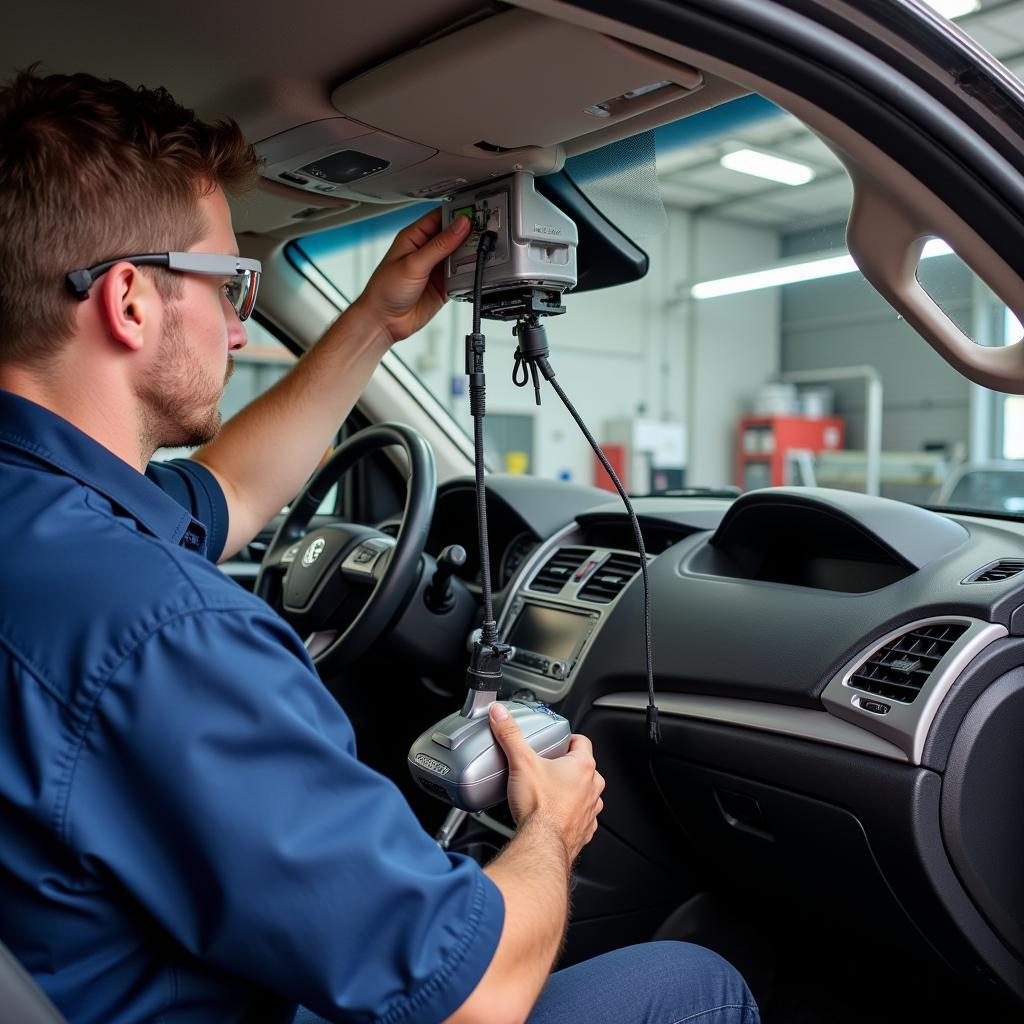A malfunctioning airbag system is a serious safety hazard. If your car’s airbag light is on, it means the system has detected a problem and may not deploy correctly in an accident. This article will guide you on how to identify, troubleshoot, and potentially fix common car air bag problems.
Understanding Your Car’s Airbag System
Modern vehicles come equipped with a Supplemental Restraint System (SRS) that includes airbags, seat belts, and sensors working together. When a collision occurs, impact sensors send signals to the airbag control unit, which deploys the airbags in milliseconds to cushion passengers.
Common components of the airbag system include:
- Airbag Control Unit (ACU): The brain of the system, processing sensor data and triggering airbag deployment.
- Sensors: Various sensors detect impact, deceleration, and passenger presence.
- Clock Spring: Located within the steering wheel, allowing electrical connections while turning.
- Airbags: Gas-inflated cushions strategically placed in the steering wheel, dashboard, seats, and sides.
Common Car Air Bag Problems and Solutions
While some issues require professional attention, certain problems can be addressed with basic troubleshooting.
1. Blown Fuse:
- Problem: A blown fuse in the airbag circuit can disable the entire system.
- Solution: Locate the airbag fuse in your car’s fuse box (consult your owner’s manual). If the fuse is blown, replace it with a new one of the same amperage.
2. Loose Wiring:
- Problem: Vibrations can loosen wiring harnesses connected to airbag components, disrupting communication.
- Solution: Carefully inspect the wiring connections to the airbag control unit, sensors, and clock spring. Secure any loose connections and ensure they are clean from corrosion.
3. Faulty Clock Spring:
- Problem: A damaged clock spring can break electrical connections to the airbag module, particularly if you experience issues with your horn or steering wheel controls along with the airbag light.
- Solution: Diagnosing a faulty clock spring often requires a multimeter to check for continuity. Replacement is usually the best course of action and should be done by a qualified technician.
4. Seat Belt Buckle Sensor Malfunction:
- Problem: A malfunctioning sensor in the seat belt buckle can trigger the airbag light.
- Solution: Check the connection under the seat for any loose wires or debris. You might try cleaning the buckle’s connector. If the problem persists, replacement of the buckle or sensor may be necessary.
5. Deployed Airbag Components:
- Problem: After an accident where airbags have deployed, the system requires a complete reset and replacement of deployed components.
- Solution: This situation necessitates professional attention. A qualified technician can replace deployed airbags, reset the airbag control unit, and ensure the system is fully functional.
 Mechanic replacing a car airbag module
Mechanic replacing a car airbag module
When to Seek Professional Help
While simple troubleshooting can address some issues, many airbag problems demand professional expertise.
Contact a qualified mechanic or dealership immediately if:
- The airbag light remains on after checking and replacing fuses.
- You suspect issues with the airbag control unit, clock spring, or sensors.
- There is visible damage to airbag components.
- The airbag light flashes a specific code.
- You’ve experienced a recent accident.
Attempting to fix complex airbag problems yourself can be dangerous and might even be illegal in some areas.
Importance of Professional Airbag Repair
Airbag systems are sophisticated and potentially dangerous if handled incorrectly. Place to get air bags fixed in car is crucial for your safety.
“Remember, safety is paramount when it comes to airbags,” advises John Miller, a seasoned automotive electrical engineer with over 20 years of experience. “These systems are intricate and demand specialized knowledge and tools for proper diagnosis and repair.”
Preventive Measures for Airbag Health
While not all problems are preventable, these tips can help maintain your airbag system’s health:
- Regular Inspections: Have your airbag system checked during routine vehicle maintenance.
- Avoid Aftermarket Modifications: Modifications to your car’s electrical system or steering column can interfere with the airbag system.
- Address Warning Lights Promptly: Ignoring warning lights can lead to more significant problems down the line.
Conclusion
A properly functioning airbag system is essential for your safety on the road. Understanding common how to fix car air bag problems and seeking professional help when necessary ensures your car’s safety features are always ready to protect you in a collision.
Remember, if you’re facing any issues with your car’s airbag system, don’t hesitate to contact AutoTipPro for expert advice and assistance. You can reach us at +1 (641) 206-8880 or visit our office at 500 N St Mary’s St, San Antonio, TX 78205, United States.





Leave a Reply